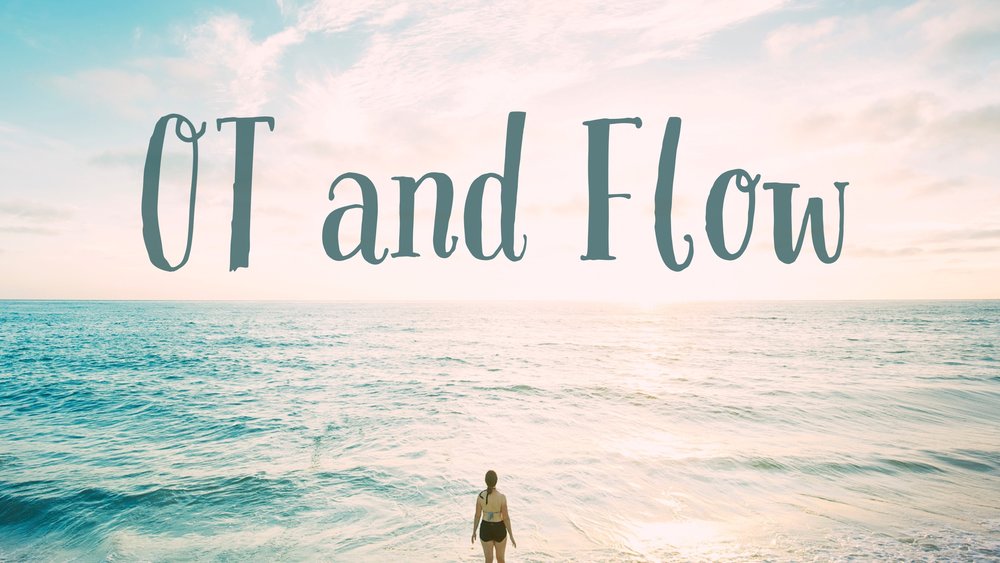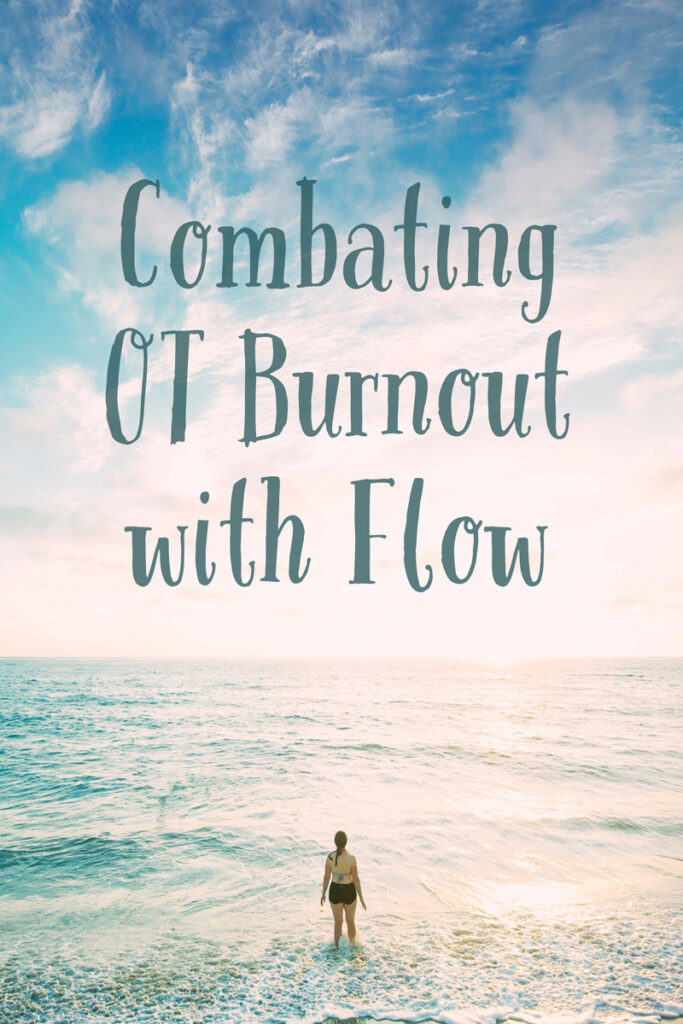
It would be nice to feel better about how the day flows…to feel as if it actually DOES flow.
I would like to be able to “get in a zone” and maximize the satisfaction that I feel not only in my work, but also in my… life.
Welcome to the internal dialogue that spurred a presentation at the Nebraska Occupational Therapy Association (NOTA) annual conference. The invitation to present came from an intention to address OT burnout. As an occupational therapist and life coach, I found myself inspired to find a topic to not just focus on the issue causing stress in occupational therapy but by looking beyond.
What would be the opposite of burnout?
What could an occupational therapist put their attention towards rather than just telling her how to avoid burnout?
Flow. I could tell that OT about Flow.
What is “flow”?
Flow is a term that floated into my life during my occupational therapy studies. Mihaly Csikszentmihalyi was the first person given credit for bringing this word and its defining meaning to a mainstream audience. He discovered that people found deeper satisfaction and ultimately “optimal experiences” when they are in a state of flow. It is defined as, “A positive feeling that occurs when there is a balance between perceived challenges and that person’s skills. It may include enjoyment, intense or complete involvement, deep concentration, or the loss of time” (Csikszentmihalyi & Csikszentimibalyi, 1988).
Check out this TED talk for more info from the Mihaly himself.

Why should I care? How can flow help OTs with burnout?
As an occupational therapist, you are in a unique place to understand the value of being able to more fully participate in the experience of life. It is in the experience, the participation, that we find meaning… both as a human being (in any role) and uniquely as an occupational therapist. The understanding of how to create and practically live an optimal experience yourself facilitates a more seamless and likely transfer of this information to those also in need… your clients.
What does the research suggest?
It was time for research. The objectives addressed in our conference presentation promised that we would bring feedback from research already done on flow, especially as it pertained to occupational therapists.
Csikszentmihalyi & Csikszentimibalyi (1988) suggest that
“…to remain in flow, an individual must increase the complexity of the activity by developing new skills and taking on new challenges. Flow forces people to stretch themselves, to always take on another challenge, to improve their abilities… [it is the process of continually] discovering something new” (p.30).
Karen Jacobs (1994) completed a study of 90 occupational therapists (OTs) in a physical rehab setting during which time OTs were asked to fill out an experiential sample form (ESF) at least three times a day during a 5 day work week. This form helps objectively identify and bring awareness to subjective experiences. According to feedback from the use of the ESF, 78 of 87 OTs experienced flow an average of 5.24 times over a 5-day work week, with a range of 1 to 12 times.
- 23% fell into flow
- 77% fell into non flow
- 44% fell into anxiety (too great of a perceived challenge or too low of perceived skill for the task)
- 29% fell into boredom (too small of a perceived challenged or too high of a skill for the task)
- 3% fell into apathy (too small of a perceived challenge and too low of a perceived skill level)
Like Csikszentmihalyi, she found that participants described flow as feeling confident, excited, positive, challenged, happy, creative and concentrated.
She boiled it down to these recommendations for practice:
- Understanding flow can enhance retention of employees.
- Redesign jobs to increase workplace flow and therefore performance, morale and prevent burnout.
- Set an overall goal with subgoals.
- Use these same goals to measure progress.
- Focus on the task and make minute changes in the challenges involved.
- Grow the skills to maximize opportunities.
- Increase the reward when activity is tedious.
- Managers… include and emphasize optimal flow strategies and experiences during the training process.
Graham Stew (2011) developed a study focusing on the impact and perceived process of participating in a training for occupational therapy students in mindfulness. Among the results (based on phenomenological input) he identified themes. One of these themes revealed was that easy concentration (often described as a synonym for feeling flow) was as a result of practicing mindfulness.
What could I do to simply apply this research to my own life?
Here’s what I’ve come up with so far. Try using one of these for increased flow in your life experience.
- Clarify your goal(s).
- Set an overall goal with subgoals.
- Use these same goals to measure progress.
- Collect immediate feedback to assist with clarity and goal achievement.
- Focus on the task and make minute changes in the challenges involved (If feeling anxious, decrease the challenge. If feeling bored, increase the challenge.)
- Grow the skills to maximize opportunities (if feeling anxious).
- Increase the reward when activity is tedious.
- Practice (or learn) Mindfulness:
- Develop a Meditation practice.
- Loving Kindness Meditation
My real life example of combating OT burnout with flow.
After doing my own flow audit, it became clear to me that during the drives between clients (for home health) was when I often felt out of flow. This was most evident by my awareness that my thoughts were consumed by (useless) worry. I judged that this was just because I was bored driving. After identifying this specific time of being out of flow, I identified the goal of the activity. The whole and only goal was: To transport myself safely to the next destination. Add to clarity of this goal, the mindfulness technique of being more present in all my senses, and I can now honestly admit to having been more in flow since applying these strategies. It helped! If I start to feel out of flow, I ask myself, “What do I hear now, smell, feel, taste or see?”
After trying use of the new form (and being inspired to have it laminated so I can use it daily), I realized the core issue at another point of frequent stress. Just as important, I also learned what I can do when it shows up. Too many goals at once. That was a key and frequent stressor. Now when I am trying to make a call and schedule and finish a note all at once, I notice this and stop to do only ONE of these goals. Flow picks back up.
I’ve only blown dust off the tip of this iceberg, my friends. Please use the resource list provided for more detailed reading on this research. The list is the full list from our presentation which also address the need for proper nutrition with mindful eating, sleep hygiene, exercise and meditation.

More from Monika
Monika started writing for OTPotential when she realized there was a lack of quality resources for the home health OT. She takes what helps in her own OT practice, and creates potent content to help other OTs. For OTs with stuck clients? Check out the article on Motivational Interviewing. Want do-it-today strategies to maximize your work & life as a home health OT (including how to make the morning appointment phone calls with a bit more ease)?
Resources
Bhasin, M.K., Dusek, J. A., Chang B., et al. “Relaxation Response Induces Temporal Transcriptome Changes in Energy Metabolism, Insulin Secretion and Inflammatory Pathways.” PLoS ONE 8(2013): e62871
Bowman, D. & Costa, D. (2014). Battling Workplace Burnout, Webinar on AOTA. (Access for Members Only)
Csikszentmihalyi, M (2008). Flow: The psychology of optimal experience.
Csikszentmihalyi, M, & Csikszentmihalyi, I. (1988) Optimal flow experience: Psychological studies in flow in consciousness. New York: Cambridge University Press.
Easterlin, R. “Will Raising the Incomes of All Increase the Happiness of All?” Journal of Economic Behavior and Organization 27(1997): 1776-80
Huffington, A. Thrive: The Third Metric to Redefining Success and Creating a Life of Well-being, Wisdom, and Wonder. Harmony Books: New York, 2014. Print.
Jacobs, K (1994). Flow and the occupational therapy practitioner. American Journal of Occupational Therapy. Jan 12.
Kabat-Zinn, J (2013). Full catastrophe living: Using the wisdom of your body and mind to face stress, pain, and illness.
Kotler, S (2014). Live life at the limits: How to hack your flow.
Lazar, S. W., Kerr, C. E., Wasserman, R. H., et al. “Meditation Experience is Associated with Increased Cortical Thickness.” Neuro-Report 16 (2005): 1893-97.
LeFebre, J. (1988). Flow and the quality of experience during work and leisure. In M. Csikszentmihalyi & I. Csikszentmihalyi (Eds.), Optimal experience: Psychological studies in flow in consciousness (pp.307-318). New York: Cambridge University Press.
Stew, G (2011). Mindfulness training for occupational therapy students. British Journal of Occupational Therapy, 74(6), 269-276.
Suarex, E. “Self-Reported Symptoms of Sleep Disturbance and Inflammation, Coagulation, Insulin Resistance and
LeFebre, J. (1988). Flow and the quality of experience during work and leisure. In M. Csikszentmihalyi & I. Csikszentmihalyi (Eds.), Optimal experience: Psychological studies in flow in consciousness (pp.307-318). New York: Cambridge University Press.
Stew, G (2011). Mindfulness training for occupational therapy students. British Journal of Occupational Therapy, 74(6), 269-276.

2 replies on “Occupational Therapy and Flow: Combating OT Burnout”
Here is a helpful tweet I received: Great article! Download guided audio body awareness, metta meditations free through UCSD. http://tinyurl.com/OTmindfulness
Thanks for the informative article. Looking forward to more informative articles from you.